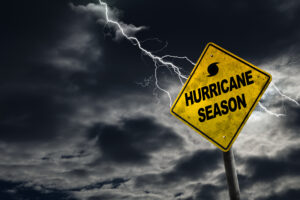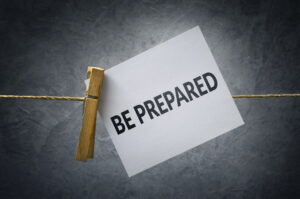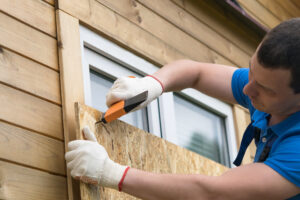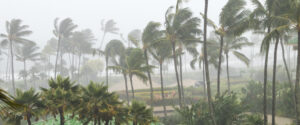Disaster Preparedness For You and Your Medical Practice

The 2023 Atlantic hurricane season begins today. Though tropical storms and hurricanes can form year-round, most brew during the six-month Atlantic hurricane season, which officially runs from June 1 to November 30 each year. In fact, 97% of all tropical cyclones in the Atlantic form during the season. North Carolina’s coast is one of the nation’s most vulnerable areas to a direct hurricane strike because its coastline extends out into the ocean. All areas of the state – from coastal and sound counties to the mountains – have been impacted by hurricanes in the past 20 years. Heavy winds, tornadoes, strong thunderstorms, flooding, storm surge and landslides can all be caused by hurricanes causing tragic damage. Here is some helpful information to help you plan now:
Hurricane Categories
Tropical Depression – contains winds up to 39 miles per hour (mph).
Tropical Storm – 39 – 73 mph winds
Category 1 – 74 to 95 mph winds
Category 2 – 96 to 110 mph winds
Category 3 – 111 to 129 mph winds
Category 4 – 130 to 156 mph winds.
Category 5 – winds 157 mph or greater.
Terms
- Hurricane Watch – hurricane conditions (sustained winds greater than 74 mph) are possible. Watches are usually issued 48 hours before the beginning of tropical-storm-force-winds.
- Hurricane Warning – hurricane conditions (sustained winds greater than 74 mph) are expected. Warnings are usually issued 36 hours before the beginning of tropical-storm-force-winds.
- Tropical Storm Warning – tropical storm conditions (sustained winds of 39 to 73 mph) are possible within 36 hours.
Is Your Practice ready?

Disaster preparedness requires a continuous cycle of planning, organizing, training, equipping, rehearsing, and evaluating. Physicians are critical participants in disaster preparedness, ensuring that patient care and critical services are not interrupted—especially for at-risk individuals who may have special medical needs.
Plan Ahead Now
Before the next disaster strikes, make sure your practice has a plan in place. A checklist, ordered by priority and customized to specific types of disasters, can provide the framework for a comprehensive plan. The checklist should include these elements:
- A full-circle call tree that outlines who contacts whom.
- Instructions for setting up instant messaging technology that enables staff to communicate without a wireless network or cellular data connection.
- Instructions for securing records of patients undergoing diagnostic testing and a list of outstanding diagnostic studies.
- Guidelines for maintaining Health Insurance Portability and Accountability Act (HIPAA) compliance. Although the HIPAA Privacy Rule is not suspended during a natural disaster or other emergency, the Secretary of Health and Human Services may waive certain provisions of the Privacy Rule.
- A Certificate of Insurance for your medical malpractice coverage, or instructions for contacting your agent or insurer directly to obtain proof of coverage. This document will be necessary if you are forced to temporarily relocate your practice or procedures.
- Verification that home health agencies caring for your patients have plans in place to provide adequate services in a disaster.
- Steps to follow upon returning from evacuation.
When Disaster Strikes
Planning today makes accomplishing the following tasks more feasible during a disaster:
Communication
- Contact staff immediately to determine realistic return-to-work time frames.
- Notify external vendors and business associates of your practice interruption and targeted resumption of operation.
- Implement staff briefings at the beginning and end of each day.
- Create temporary phone, fax, and answering services.
- Establish patient telephone triage.
- Implement temporary controls to ensure HIPAA compliance.
Computers and systems
- Contact computer service vendors to ensure integrity and recovery.
- Verify insurance coverage for repair or replacement costs and losses.
- Evaluate applicable warranties and consider an information technology restoration service contract.
- Inventory and document hardware and software.
- Document the type and extent of both lost electronic and paper data.
- Ensure data back-up and periodically test compliance.
- Reestablish filing systems and internal programs.
Medical records
- Determine the extent of damage to, or loss of, patient records and filing systems.
- Attempt to restore all damaged charts and document inventory findings.
- Notify the state medical board for specific guidance pertaining to lost or damaged records.
- Document all efforts to restore and protect existing records.
- Reconstruct lost charts at the next patient encounter.
- Contact your insurance carrier for restorative services and/or claim procedures.
- Reestablish a filing system and temporary storage if necessary.
- Obtain legal guidance for patient notification during recovery efforts.
- Contemporaneously date and initial all late entries and duplicate information in context of recovery efforts.
In addition, create an inventory of all equipment and medications that may have been exposed to water or extremes in temperature. Repair, replace, or discard damaged items appropriately.
Once your plan is in place, regularly reevaluate its steps and update all contact information. Practice and rehearse the plan’s protocols. An effective disaster preparedness plan will help keep your practice focused on delivering care during an emergency.
Is Your Home and Family Ready?

To get ready for a hurricane:
- Build an emergency kit.
- Make a family communications plan.
- Know you’re the routes you need to leave your home (evacuation routes). Locate your local emergency shelters.
- Closely watch/listen to the weather reports. Listening every hour as the storm nears.
- Put fuel in all vehicles and withdraw some cash from the bank. Gas stations and ATMs may be closed after a hurricane.
- If authorities ask you to leave, do so quickly.
- If you leave (evacuate), be alert to flooded or washed-out roads. Just a few inches of water can float a car. Think: Turn Around, Don’t Drown.
- Keep a photo I.D. that shows your home address. You will need it when asking police if it is okay for you to re-enter your area or home.
- Secure your property.
- Bring inside all outdoor furniture, decorations, garbage cans and anything else that is not tied down.
- Cover windows with permanent storm shutters or board up windows with 5/8” plywood, cut and ready to install. Tape does not stop windows from breaking.
- Put in straps or extra clips to securely fasten your roof to the frame structure. This will lower roof damage.
- Trim trees and shrubs around your home, so they are more wind resistant.
- Clear clogged rain gutters and downspouts.
- Reinforce garage doors. If wind enters a garage it can cause dangerous and expensive structural damage.
Evacuating
In some emergencies, local officials may tell people to leave their home to keep residents and visitors safe. Fires, floods or chemical accidents require evacuations frequently across the country. At other times, fire fighters and police tell people to stay indoors, or ‘shelter in place.’
The amount of time you have to leave will depend on the danger. You may be told ahead of time, as with a hurricane. Or, you may not have much time to leave as in the case of industrial accidents. Always follow the orders of the local emergency officials.
Follow these guidelines when evacuating:
- Listen to local media.
- Fill your car with gasoline. Take only one vehicle to lower the amount of traffic.
- Leave early enough to avoid being trapped by severe weather.
- Plan where your family will meet and go. Tell family or friends of your plans.
- If possible, stay with family or friends in a safe area. Next, try a motel or hotel. As a last resort, go to a shelter. Remember, shelters are not made for comfort and should be places of last resort.
- Map out your path, using major roads. If local officials suggest certain evacuation routes, use those roads
- Always take pets with you when evacuating.
- Don’t forget emergency kits for your family and pets. Bring key family papers.
- Bring extra cash. Banks may be closed, and cash tellers may not work.
- Lock doors and windows before leaving your house. Unplug radios, toasters, televisions and small appliances. Be sure to turn off water, gas and power.
- Ask neighbors if they need a ride.
Evacuation routes in North Carolina
Evacuation Zones – Know Your Zone
Are Hurricane Evacuations Mandatory?
Staying Put

There may be times when it’s simply best to stay put to stay away from possible dangers outside. You may also need to stay put to keep you away from possibly dangerous air outside. Use common sense. Information will be given so you can decide if you are in danger. If you see a lot of trash in the air, or if fire fighters and police say the air is badly tainted, you may want to take this kind of action. The process used to seal the room is thought to be a short-term protective way to make a barrier between you and possibly bad air outside. It is a type of sheltering in place that needs preplanning.
If fire fighters, police or other officials tell you to stay indoors, be sure to:
- Bring your family and pets inside.
- Lock doors, close windows, air vents and fireplace dampers.
- Turn off fans, air conditioning and forced air heating systems.
- Get your emergency supply kit unless you have reason to believe it has been dirtied or is unclean.
- Go into an inside room with few windows.
- Seal all windows, doors and air vents with 2-4 mil. thick plastic sheeting and duct tape.
- To save time, measure and cut the sheeting in advance. Cut the plastic sheeting many inches wider than the openings. Label each sheet.
- Duct tape plastic at corners first. Then tape down all edges.
- Be ready to wing it. Use what you have on hand to seal gaps so that you make a barrier between yourself and any contamination.
- Fire fighters and police may not instantly be able to give information on what is happening and what you should do.
- You should watch TV, listen to the radio or check the Internet often for official news and instructions as they become available.
For more information about disaster preparedness you can go to www.readync.gov.
